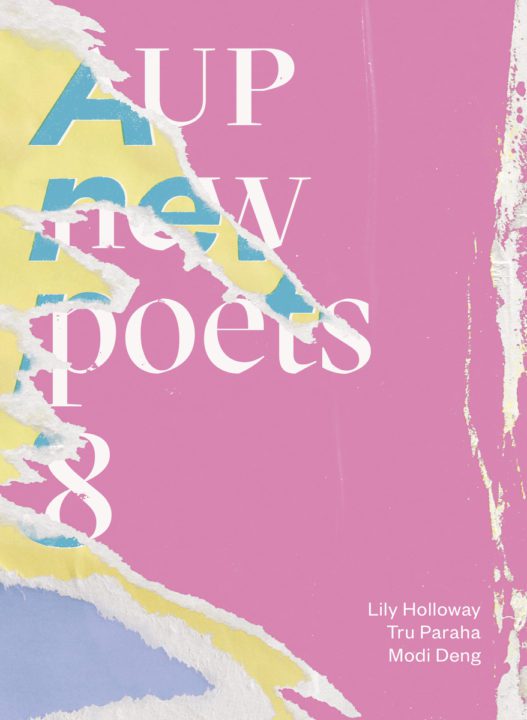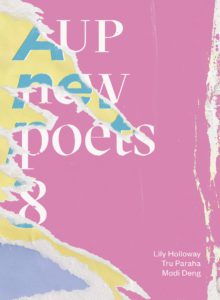AUP New Poets 8

AUP New Poets 8.
Lily Holloway, Tru Paraha, Modi Deng.
Edited and with a foreword by Anna Jackson.
Auckland University Press, ISBN: 20219781869409456.
RRP: $29.99. 120 pp.
Review by Mary Cresswell.
Lily Holloway, Tru Paraha and Modi Deng all share a skill in moving beyond traditional poetry constraints in this collection. Each of them sustains a poetic of their own, and the three together form a book that is readable. It’s the latest in the AUP New Poets series edited by Anna Jackson.
Holloway presents what at first appears to be childhood memories, but these are only a clue to the cast of characters, not the story itself. It’s a new language, with nouns from the world we share with her but with a syntax unique to her imagination.
She wonders aloud why the sky is so pink
but it’s not, you say
maybe she’s looking at a sky that has passed
a passenger to heritage or history
inaccessible to you.
(“Is any of this relevant?” p 19)
She uses a variety of styles: erasures, tabular material, wide variation in spacing. Each poem stands separate, using visual and verbal effects to make her points, but the variation itself holds the individual pieces together.
Paraha explores space by using space. The words themselves fluctuate like variable stars. It’s up to us to translate the feelings (or possible meanings) attached to the various survivors. This whole section is a wide-ranging nature poem, reflecting a cold universe object by object, in a mixture of te reo and English, words displayed in Morse code and sans serif type. There is the feel of a single consciousness but one which is deliberately hidden from us by the speed with which it is bouncing back and forth through time and space.
was where this had they
mind in (dyslx
suicidal deepspace
metasex mourn out
dark script
come . _
lie with
(untitled, p 67)
Words, letters and asterisks are scattered throughout, different for almost every poem. The focus varies from the almost-descriptive:
“beyond chorus of extinction distinctly resounding by forest lake swamp skin offering/ beside furrowed bean pea beet potato courgette near Bastion pā bunkers to church palisade” (p 61)
to a very nice cannibal piss take on page 71.
Deng approaches us in yet another way. At first glance, her poems seem to fall in conventional forms, coming together to seem autobiographical, but do we really know this? Perhaps she is assembling a deceptively conventional personality and we must read between the lines to find what we will then believe is the poet’s own voice.
Deng specifically references other performers – Monet, McCahon, Lewis Hyde, Brahms, Beethoven – and this keeps us aware that she is showing us herself, sharing in the world. Many of her poems set up an interaction with others. They are all clear about immediate topics and where they might lead.
5. she imagines that music is a kernel
of strength, maybe that she could grow roots
down into the earth
musty with garden moss and tarred
by the rain, shoot up sound and
space through her limited frame, touch a dimming
sky through a clothesline
(“reflects”, p 89)
Each poet introduced here shows herself in a world of her own delineation and it’s up to us to follow. The journeys are unique and well-considered; each of them well worth the travel.
